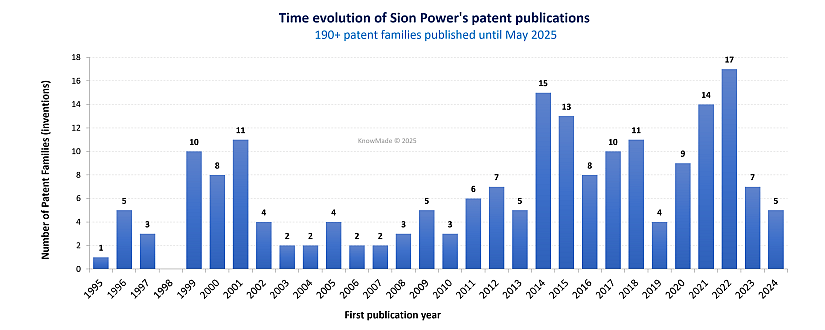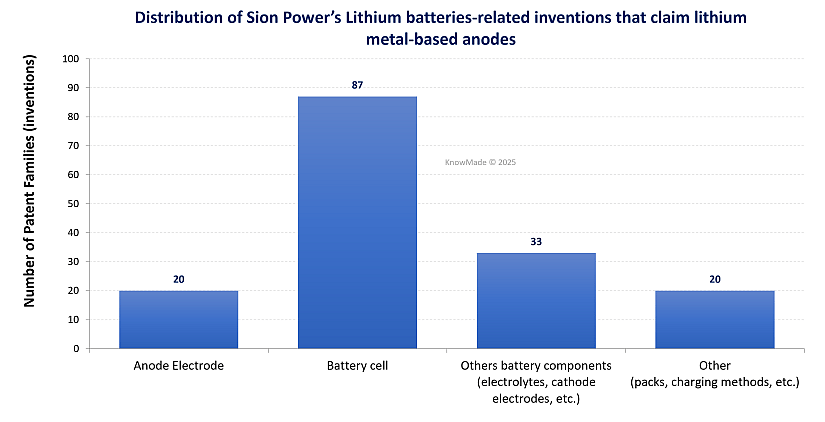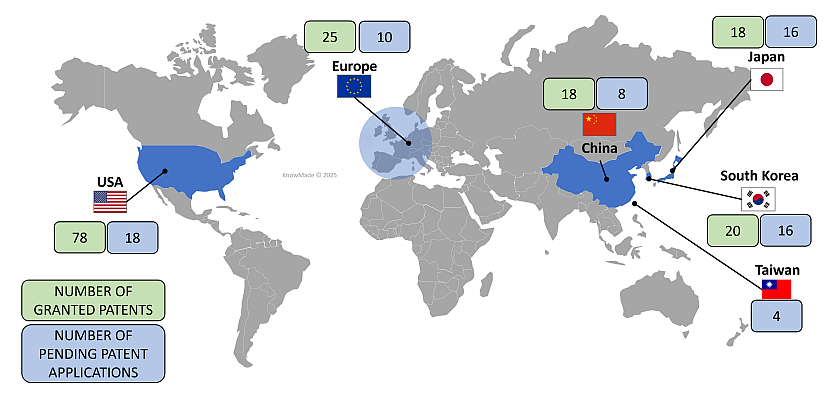SOPHIA ANTIPOLIS, France – June 03, 2025 │The increase in energy density is one of the main drivers for battery technology. Lithium metal anodes can enhance battery performance, but several technical challenges exist, slowing the adoption of this technology. R&D laboratories and industrial companies quickly recognized the potentiality of lithium batteries with lithium metal anodes leading to significant investments to bring this technology to market.
In such a highly competitive and dynamic environment, analyzing the patent landscape is essential to understand the technology strategies of key players and their intellectual property (IP) positions. In most of KnowMade’s research, analyzing battery pure players and start-ups among patent holders is a crucial component. Their patent portfolios reveal the specific technologies they are focusing on and the key market areas they aim to secure.
Sion Power’s Strategic Growth: From Lab Spin-Off to Li-metal Battery Pioneer
Founded in 1989 as Moltech, a spin-off from Brookhaven National Laboratory, Sion Power is a battery pure player that develops high-energy lithium-metal rechargeable battery technology. Moltech changed its name to Sion Power in 2002 to reflect its focus on integrating sulfur-based compounds into lithium batteries. According to BloombergNEF, Sion Power has raised $145 million as of September 2024, possibly through private equity, venture capital, and grant funding. In November 2021, Cummins has invested in Sion Power to co-develop large-format Li-metal battery cells using Sion Power’s Licerion® technology for integration into Cummins’ commercial electric vehicle powertrains, supporting the transition to high-performance, low-emission transportation. In January 2024, Sion Power has raised $75 million in Series A funding, led by LG Energy Solution and other high-profile investors, to commercialize its high-energy-density Licerion® lithium-metal battery technology for electric vehicles. In March 2025, Sion Power has advanced the commercialization of its high-energy Licerion® lithium-metal battery technology by launching a new large-format cell production line in partnership with Mühlbauer Group, significantly scaling production capabilities and appointing new leadership to accelerate market readiness by 2028.
Focus on Sion Power’s Lithium Batteries-Related Inventions that Claim Lithium Metal-Based Anodes
As of May 2025, Sion Power holds over 190+ patent families (inventions), with approximately 134 Lithium batteries-related inventions that claim lithium metal-based anodes. The remaining patents cover more general inventions, such as electrochemical cell management systems, apparatuses for processing battery cell components, etc. The evolution of Sion Power’s patent publications reflects key stages of its technological and commercial strategy (Figure 1).

Figure 1: Time evolution of Sion Power’s patent publications
In considering the lithium batteries-related inventions that claim lithium metal-based anodes, a first wave of patent filings, between 1995 and 2007, corresponds to Sion Power’s pioneering work on this technology. Following a transitional period, a renewed phase of patenting activity between 2011 and 2018 likely corresponds to the developments of Licerion® technology (which was mentioned in Sion Power’s news section for the first time in 2016 : see LG Chem Acquires Rights to Sion Power Technology and Sion Power Delivers Next Generation Battery Performance through Patented Licerion Technology). Licerion® technology is a product of Sion Power’s technical collaboration with BASF, and it covered a wide range of chemistries designed to performed with sulfur-based and conventional lithium ion-based cathodes. Several patent co-filings about lithium batteries-related inventions that claim lithium metal-based anodes were made jointly by Sion Power and BASF between 2011 and 2019. This technology made the shift to lithium-metal chemistry with protected anodes, optimized electrolytes and engineered cathodes. A new phase of R&D and innovation starting in 2019-2020, peaking in 2022, coincides with major advances: production of 6 to 20 Ah cells for electric vehicles and strategic investments, for example, by Cummins (2021). During this latest phase, lithium batteries-related inventions that claim lithium metal-based anodes are more closely linked to applied systems such as battery management systems (WO2021/086377) and apparatuses (like systems for cutting lithium-metal layers (US20210138673)), among others. In 2025, the installation of a large format cell production line confirms Sion Power’s entry into the commercialization phase supported by its patent portfolio. Thus, the dynamics of patent filings clearly illustrate Sion Power’s rise, from fundamental research to the industrialization of improved lithium-metal solutions.
The distribution of Sion Power’s patent portfolio linked to lithium batteries-related inventions that claim lithium metal-based anodes (Figure 2) reveals that the majority of patent families (87 inventions) focus on battery cell design, highlighting the company’s strategic emphasis on optimizing complete lithium-metal cell architectures. This is followed by 33 inventions related to other battery components, such as electrolytes and cathodes, indicating complementary innovations aimed at enhancing cell performance. In contrast, anode electrode technologies and other categories (e.g., battery packs and charging methods, etc.) each comprise 20 patent families, suggesting a more selective yet still significant focus on these areas. Overall, this distribution reflects a holistic approach to battery innovation, with a clear priority placed on core cell integration and performance advancement.

Figure 2: Distribution of Sion Power’s Lithium batteries-related inventions that claim lithium metal-based anodes. Note that a patent family can belong to multiple segments.
Strategic IP Deployment: How Sion Power Protects Its Li-Metal related Battery Technologies Globally
Sion Power has implemented a truly global IP strategy to protect its Lithium batteries-related inventions that claim lithium metal-based anodes (Figure 3). The United States is the dominant territory, with 78 granted patents and 18 pending applications, reflecting the company’s strong domestic protection of its inventions and likely commercialization focus. Asia represents a key strategic region as well, with significant patent activity in South Korea, Japan and China, underscoring efforts to secure IP in competitive battery markets. In Europe, Sion Power’s inventions are also robustly protected in this major market. Although Taiwan jurisdiction shows only 4 pending applications and no granted patents, its inclusion suggests interest in future activity. In Taiwan, the patent applications are primarily related to battery cells. Overall, this geographical distribution of active patents highlights Sion Power’s global IP strategy, which is focused on securing its inventions in key battery manufacturing and automotive markets.

Figure 3: Geographical coverage of Sion Power’s Lithium batteries-related alive patent assets that claim lithium metal-based anodes.
Pushing the Limits: Sion Power’s Inventions in Lithium-Metal Anode Protection
Inventions in lithium-metal anodes are crucial for advancing next-generation battery technologies. By addressing key challenges such as dendrite formation, limited cycle life, and safety concerns, innovations in this segment pave the way for improved batteries, essential for applications like electric vehicles and aerospace. Several Sion Power’s inventions related to anodes with lithium metal-based components are detailed below (Figure 4):
- The patent application EP4174984, addresses the long-standing challenges associated with lithium-metal electrodes in lithium batteries, particularly their instability and tendency to undergo undesirable reactions during fabrication and cycling. To overcome these issues, the inventors propose a suite of innovations involving lithium-metal layers with specialized passivating coatings that could include elements like boron, phosphorus, antimony, etc. These passivation layers, which can feature columnar structures, help stabilize the lithium surface.
- The patent US12113208, addresses the technical challenges associated with the instability and reactivity of lithium-metal electrodes, which can lead to safety risks and reduced battery life. The inventors propose a solution involving a composite protective layer composed of particles and a polymeric binder that is applied to lithium metal-based electroactive materials. The protective layer materials are selected for their ability to react with lithium or intercalate lithium, thereby forming a more stable interface that mitigates lithium dendrite formation and enhances overall electrode durability.
- The patent EP3246968, addresses the problem of electrolyte degradation and shortened cycle life in lithium-based batteries caused by undesirable reactions between metallic lithium electrodes and the electrolyte. Existing protective solutions are insufficient in durability or efficiency. To overcome this, the inventors propose an electrode structure comprising a dual-layer system: a first layer and a second layer made of fused particles, which are at least partially embedded in the first layer. This second layer acts as a protective barrier that prevents direct contact between the electrolyte and the reactive lithium surface.
These inventions exemplify Sion Power’s strategic commitment to overcoming the intrinsic limitations of lithium-metal anodes, enabling safer, more durable, and higher-performing batteries.

Figure 4: Examples of Sion Power’s recent inventions focused in the segment of lithium metal-based anodes
From IP to Insight: Understanding the Role of Pure Players in Shaping Battery Technology
Analyzing the patent activity of battery pure players, i.e. companies focusing on specific battery technologies (such as lithium batteries with lithium metal-based anodes), offers valuable insights into innovation trends and strategic directions. Their patent portfolios reveal targeted research and development efforts, highlighting areas of technological advancement and potential market disruption. By studying these entities, stakeholders can identify emerging technologies, assess competitive dynamics, and make informed decisions regarding partnerships, investments, and R&D strategies.
Throughout the year, KnowMade’s analysts track and analyze the latest patenting activities of competitors involved in developing cutting-edge battery technologies. These include efforts to increase energy density (e.g., silicon anodes, Li-metal anodes, NMC cathodes, anode-less designs), improve safety and longevity (e.g., solid-state batteries, thermal management solutions), reduce costs (e.g., LFP/LMFP cathodes, Na-based batteries), and minimize environmental impact (e.g., battery recycling). By doing so, KnowMade provides a comprehensive view of the IP landscape shaping the future of energy storage technologies. In the context of custom studies, KnowMade can investigate technological evolutions through in-depth analysis of patents and scientific publications. Our team is used to examining patents in detail and synthesizing the technical solutions they disclose, whether related to materials, processes, devices, or systems.
Press contact
contact@knowmade.fr
Le Drakkar, 2405 route des Dolines, 06560 Valbonne Sophia Antipolis, France
www.knowmade.com
About the author
Arnaud Capgras works for KnowMade as a Patent Analyst in the field of Materials Chemistry and Energy storage. He holds a Chemistry-Process Engineering Degree from the Chemistry and Chemical Engineering School of Lyon (CPE Lyon, France). He also holds the International Industrial Property Studies Diploma (Patents) from the CEIPI (Strasbourg, France).
About KnowMade
KnowMade is a technology intelligence and IP strategy consulting company specialized in analyzing patents and scientific publications. The company helps innovative companies, investors, and R&D organizations to understand competitive landscape, follow technological evolutions, reduce uncertainties, and identify opportunities and risks in terms of technology and intellectual property.
KnowMade’s analysts combine their strong technology expertise and in-depth knowledge of patents with powerful analytics tools and methodologies to turn patent information and scientific literature into actionable insights, providing high added value reports for decision makers working in R&D, innovation strategy, intellectual property, and marketing. Our experts provide prior art search, patent landscape analysis, freedom-to-operate analysis, IP due diligence, and monitoring services.
KnowMade has a solid expertise in Compound Semiconductors, Power Electronics, Batteries, RF Technologies & Wireless Communications, Solid-State Lighting & Display, Photonics, Memories, MEMS & Sensors, Semiconductor Packaging, Medical Devices, Medical Imaging, Microfluidics, Biotechnology, Pharmaceutics, and Agri-Food.
